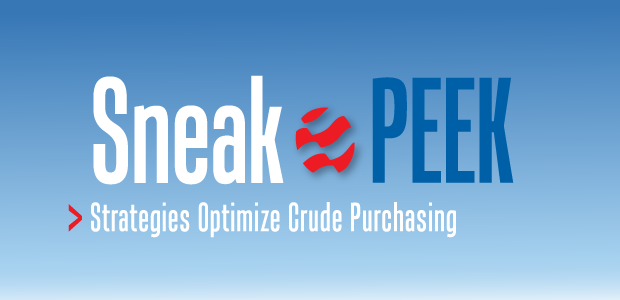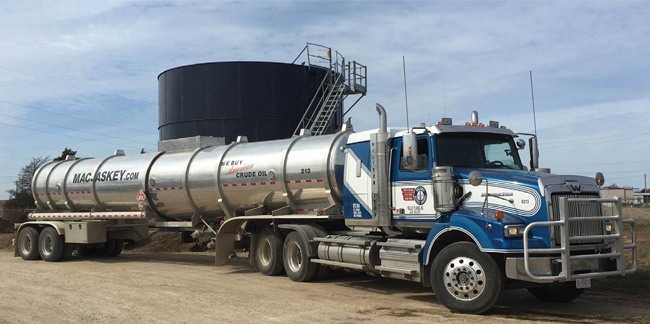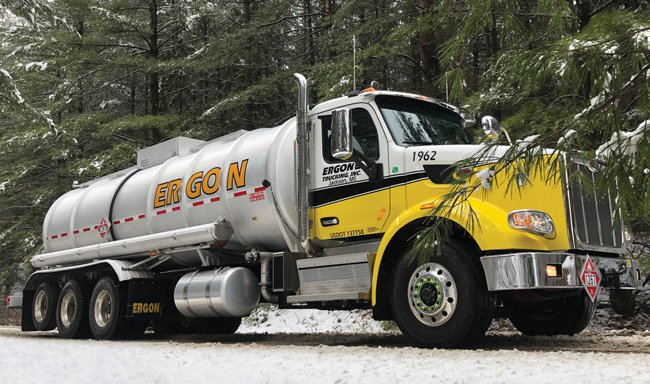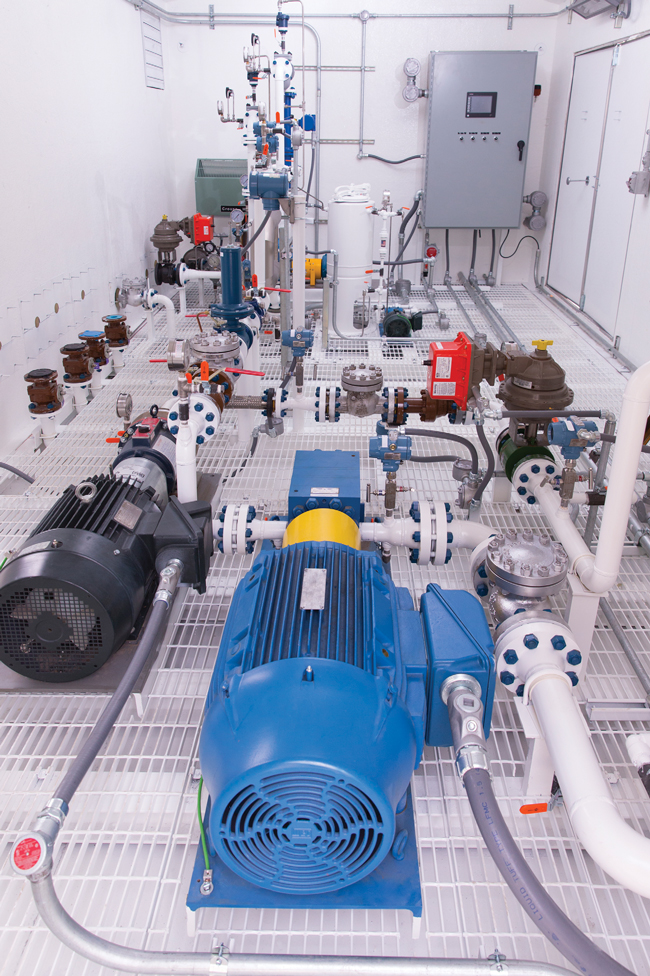
Crude Purchasing
Strategies Optimize Crude Purchasing
By Tim Beims and Kari Johnson
For four generations, the Maclaskey name has been associated with crude oil purchasing and transportation services, beginning in Eastern Kansas in 1924. Today, Maclaskey Oilfield Services Inc. has a fleet of state-of-the-art equipment for oil and water hauling, well servicing, pumping and other operations in Kansas, Oklahoma, Texas and New Mexico.
A lot has changed since Walter L. Maclaskey–the first generation of crude oil haulers in the family–transported his first load on a Model T truck. But just as it was back then, accurate oil quality and volumetric measurements are critical for both the producer and the purchaser. Even something as subtle and unavoidable as seasonal shifts in ambient air temperatures can impact the performance of the gun barrel and processing equipment, affecting the emulsion of the production stream entering storage tanks, especially for lower-gravity and paraffinic oils.
“In the different basins and field pools in the regions we serve, there are various specific crude oil characteristics–from low-gravity heavy asphaltenes to high-gravity condensate,” reports Kelly Maclaskey, president of the El Dorado, Ks.-based company. “The majority of the producers we deal with strive to have their lease crude ready to sell by meeting merchantable specifications.”
Regardless of the type of produced crude, Maclaskey says production best practices are a must for meeting crude purchasing specifications. That includes maintaining surface and subsurface equipment in optimal condition, and keeping gun barrels, water knockouts, continuous-duty chemical pumps, etc., clean and functioning properly. “Most production personnel employ best practices to ensure crude oil is coming into stock ready to transport and sell,” he relates.
Oil quality remains as important for both the producer and the purchaser as it was in the 1920s when the Maclaskey family started transporting crude oil in eastern Kansas. Today, Maclaskey Oilfield Services Inc. employs a number of best practices to help producers meet crude purchasing specifications, including maintaining surface and subsurface equipment in optimal condition, and keeping gun barrels, water knockouts, continuous-duty chemical pumps, etc., clean and functioning properly.
Contractually, oil quality is a key part of the language of any purchase agreement, Maclaskey explains, adding that his company not only analyzes oil at the tank battery before loading to a truck, but also regularly conducts crude oil spot checks at various points throughout its operations to further ensure quality control.
“Quality specifications are part of our division order purchase agreements,” he provides, noting that accurate pipeline grades and measurements govern and control all settlements. Specifically, the terms of the agreements include granting the purchaser the right to determine corrected volume and gravity at a temperature of 60 degrees Fahrenheit, and deduct from corrected volumes based on the percentages of basic water and sediment (BS&W) and other impurities.
In cases where the quality of the oil is not considered merchantable, the purchaser reserves the right to refuse the load. That gets back to the importance of the producer developing and adhering to best practices to ensure merchantable specifications. “Because of the variances in crude oil characteristics from one location to the next, best practices usually need to be done on a well-by-well and lease-by-lease basis,” Maclaskey concludes.
Maximizing Valuations
Jackson, Ms.-based Ergon is a multigenerational family-owned business with diversified independent refining operations and crude purchasing, transportation, marketing and storage services. Nick Andreychek is Ergon’s manager of crude and condensate supply, focused primarily on purchasing and transporting 25,000-26,000 bbl/d throughout the Appalachian Basin to supply the company’s refinery in Newell, W.V.
“We buy oil produced in the Utica and Point Pleasant plays, but our bread and butter is conventional assets in Pennsylvania, Ohio, West Virginia and Kentucky,” he explains. “These are low-volume wells operated predominately by small companies and sole proprietorships that generally do not have supervisory control and data acquisition or automated tank alarms, as one might see utilized on unconventional pads and tank facilities. It is old school API-standard tank gauging on the lease and making sure we meet customers’ service needs and pick up scheduled loads within a specified amount of time.”
Ergon purchases and transports 25,000-26,000 bbl/d throughout the Appalachian Basin to supply the company’s refinery in Newell, W.V. Given Appalachia’s unique operational environment with predominately low-volume wells and terrain that challenges truck access to tank batteries, good relationships and open communications between oil producer and oil purchaser are key to coordinating services and helping operators get the most value for their crude.
Ergon has five terminal facilities throughout the basin that receive the collected oil and use LACT and Coriolis meters to obtain billable volume and BS&W measurements to verify manual tank gauge data obtained at the lease. “The majority of the crude we receive is paid through metered data,” he notes.
Conventional Appalachian sandstone reservoirs yield oil along with natural gas, albeit at low daily rates compared with the unconventional shale wells that dominate drilling programs today. “The economic viability of these wells hinges on both crude and natural gas prices, which have been moving in the right direction,” Andreychek observes. “However, the produced oil tends to have high paraffin content and higher BS&W. These characteristics, and the fact that production rates can range from one to 50 bbl/d, can challenge production economics.”
Then, of course, there is the Appalachian terrain, which poses no shortage of obstacles for reaching lease locations with an 18-wheel tanker truck. “The opportunity to build lease roads to accommodate tractor-trailers simply does not exist in many places,” he states. “We often load onto triaxles and straight trucks, and because of the low volumes, we work with producers to have multiple leases to load at with one truck in order to get a full truckload.”
Given the unique operational environment, Andreychek says Ergon must maintain good relationships and open communications with producers to “develop a very real level of trust that we will deliver on promised services in order to keep their operations running and help them utilize different pricing mechanisms to get the most value for their crude.”
Last April 20, when WTI prices turned negative, Ergon responded by ending its monthly average regional price valuation on April 19, averaging prices posted only during the first 19 days of the month, before the bottom temporarily fell out. “As that day unfolded, it became evident to us that it was an anomaly and not a real representation of the market value of oil,” he relates. “We made the decision to end our monthly average valuation on April 19 in an effort to try to insulate producers from negative pricing, recognizing the challenges they face producing conventional stripper wells in Appalachia.”
Since the days of Colonel Drake, producers in the region have had to figure out how to move oil to market through a mountainous landscape with steep grades and narrow, twisting and turning roads that can be difficult to navigate under ideal conditions, let alone during snowy winters and rainy springs. Lease accessibility impacts not only the timing of when a tank volume can be picked up, but can also affect per-barrel pricing based on how much oil can be hauled in a single trip, Andreychek explains.
“The more oil we are able to get on one truck the better in terms of pricing. A load of 60-100 barrels is priced differently than a load of 150-plus barrels based on the cost associated with transporting the oil,” he says. “If there is an opportunity to get more oil in one truck run, there is an uptick in the economic benefit for the producer.”
According to Andreychek, Ergon cooperatively conducts site evaluations with operators to recommend improvements to make locations accessible for tractor-trailers. “For a lease that produces a load a couple times a year, the producer may be better off hauling the oil with a triaxle or straight truck. But on a lease that produces a load once or twice a month, the producer could get higher valuations by getting a semi to the tank battery to load more oil in each trip,” he offers.
The same access issues that complicate crude transport apply to water hauling. “The lower the BS&W the better for pricing, but we generally allow a little higher BS&W tolerance on the oil we pick up than the standard 1%,” he relates. “That helps reduce the amount going into the water tank on the lease and lessens the need for water hauling. It is another way we can work with producers to allow them to get better value for the crude from conventional legacy assets.”
To improve logistics management, the company has implemented a new dispatching and routing software system across its crude hauling and transportation fleet, he reports. “This technology has been instrumental in improving the operational efficiency of our trucking arm. It is making our trucking services an even more well-oiled machine.”
Crude Oil Cash Register
In a business environment where so many producing companies are committed to funding operations internally through cash flow, no producer wants to have a tank of “bad oil” rejected or see what they thought was the measured tank volume “shrink” because of quality issues. Generating economic value from every drop of oil and condensate produced on a lease is where lease automatic custody transfer (LACT) units come into play, says Thomas Gentry, chief executive officer of Joshua, Tx.-headquartered UMC Energy Solutions Inc.
“The LACT unit is the cash register in the production process. No one would operate a movie theatre or restaurant without a cash register. It is really no different for a production site or pipeline,” likens Gentry. “Once the producer has a properly designed LACT unit installed, they can be sure their sales volumes are being accurately measured and accounted for.”
Regardless of whether the end user is a producer or midstream or pipeline company, the primary value driver behind LACT units is improved revenue capture. LACT units automatically measure temperature, pressure, gravity, flow and other variables to eliminate the volumetric “shrinkage factor” associated with manual custody transfer measurements and increase sales revenues even in lower-volume applications.
The purpose of a LACT unit is to not only precisely meter quantity, but also automatically sample and analyze oil quality while transferring the metered volume from the tank battery into a pipeline or truck, he notes. “Crude oil is sold on a calculation of temperature, BS&W, API gravity, and overall volume,” Gentry observes. “Having accurate and reliable quantity and quality measurements is critical. When it comes to maximizing the value of the crude oil, quality is ultimately as important as quantity.”
While LACT units traditionally have been associated with higher-flow applications, Gentry says smaller-sized units are being routinely deployed on sites producing as few as 150-200 barrels a day. Not surprisingly, as activity levels across the Permian Basin region start to build with WTI pushing ever-nearer to $60/bbl, so too is the demand for LACT technology, according to Gentry.
Regardless of whether the end-user is a producer or midstream or pipeline company, the primary driver behind the demand for LACT units is the same at $55 oil as it is at $75 oil: improved revenue capture. “Once the producer understands the economic benefits of LACT units, they will want the technology on every site,” he states.
As Gentry explains it, the traditional rule of thumb in calculating manual custody transfer measurements was to apply a volumetric shrinkage factor to account for sampling conditions, pressure and temperature changes, measurement error, etc. LACT units automatically measure temperate, pressure, gravity, flow and other variables.
Because crude oil expands and contracts roughly at a rate of 2% for every temperature change of 40 degrees Fahrenheit, temperature is particularly critical in custody transfer measurements. Without the ability to accurately account for temperature dynamics, manual tank gauging commonly results in 2% shrinkage in the overall sales volume, he continues. So, if the calculated shrinkage is 2%, a producer that gauged 1,000 barrels at a tank battery would receive credit for 980 barrels. “That may not sound like much until you look at how the losses add up on a monthly or annual basis,” Gentry remarks.
Capturing Revenue
At an oil price of $50/bbl, those 20 barrels would equate to $1,000 in lost revenue. On a lease that produces 1,000 bbl/d, losing 20 barrels each day to shrinkage would add up to $7,000 a week. “You are potentially talking about more than $350,000 a year in lost revenue from one tank battery,” he points out. “A site making 2,000 bbl/d could capture upwards of $700,000 a year. The magnitude of the potential losses grows even larger at oil prices above the $50/bbl reference. There is huge value in installing a LACT unit for automatic metering and measurement.”
And that holds true even for lower-volume sites, Gentry reasons. UMC Energy Solutions’ customers are using LACT units in a range of applications, from pipeline and midstream facilities moving tens of thousands of barrels a day to individual wells making less than 200 bbl/d. While the economic benefits multiply as daily volume increases, Gentry says those benefits can be very compelling for right-sized LACT units on smaller-volume sites.
“In the shale world, where wells come on line at high initial rates, a LACT unit can pay for itself in only a few weeks. On the other end of the spectrum, let’s consider a 200 bbl/d lease,” he details. “That lease would produce about 6,000 bbl/month, so losing 2% in shrinkage at $50/bbl would be $6,000/month, or $72,000 annually. In one year, the extra revenue capture could more than pay for a properly designed LACT unit.”
Because LACT units can be configured to meet such a wide range of specifications and conditions, each system should be designed specific to the application to maximize the return on the investment, Gentry offers. “There are tons of ways to design a high-quality LACT unit that will meet even the most stringent specifications and still be cost effective,” he says. “For a lower-volume site, that may mean scaling down the skid and utilizing a different meter technology, but there will still be value in capturing revenue that would otherwise be lost.”
UMC Energy Solutions’ LACT units utilize industry-leading components through its strategic partnerships with Emerson Process Management, Rosemount and Rockwell Automation, including Coriolis, density, magnetic and vortex flow measurement technologies. The company was one of the innovators of combination designs that integrate a LACT unit with a pipeline pump on a single skid, eliminating the need to maintain multiple skids at a pipeline entry point, according to Gentry.
“These all-in-one skids have the LACT, the pump for boosting pressure to pipeline specs, the electrical panels, system controls and everything else on one modular skid. The customer has to run one 480-volt power line and install the piping to hook it up to the pipeline and it is ready to go,” he offers. “The result is lower overall costs and improved efficiencies.”
Improving Measurement
Accurate measurement at custody transfer is crucial to both producer and receiver. It determines the economic value realized, and affects everything from allocation to reporting, accounting and field planning. Errors and delays can have real consequences, says Stephen Anson, director of measurement for W Energy Software.
Contracts typically specify which party is responsible for measurement, with the other party as witness. “Automated level measurement has emerged as an accepted practice, reading open and close and calculating volume, thanks to advances in technology and industry standards,” Anson details, noting that the measurement technology employed varies based on preference and economic value.
“Some of the more traditional technologies are still widely used because they are affordable, accurate and fit for purpose, and the range of solutions include, turbine and positive displacement, with Coriolis and ultrasonic flowmeters for dynamic liquid measurement increasing in popularity due to performance advantages and diagnostic capabilities,” he continues.
Still, even the most advanced metering solutions can be adversely affected by the presence of gaseous hydrocarbons. “When measuring from atmospheric vessels like storage tanks, accuracy should be high as long as the oil was in the tank long enough for all the gas to break out,” he explains. “This can be a challenge in shale plays, where high gas-to-oil ratios are common.”
Anson likens this phenomenon with the behavior of a chilled can of soda. “When you pop the top, the can becomes noticeably flimsier and you hear the carbon dioxide release,” he says. “Take a sip and you get a bubbly sensation, because there is still gas suspended in the liquid. A few hours later, the gas will have escaped and the soda will be flat. This is essentially what has to happen to achieve stabilized oil.”
Oil producers create this “dead oil” by actively driving out the gas at the well site, or increasingly, at central facilities. Separators, heater treaters and stabilizing towers increase temperature and decrease pressure to allow the gas molecules to separate, according to Anson. This processing equipment breaks out as much gas as possible before the crude goes to sales or custody transfer. If the gas hydrocarbons are not liberated from the oil, he says, the measurement equipment may over-register the actual liquid volume and experience volumetric shrinkage once all of the gas is liberated.
Blended oil can also lead to measurement anomalies. “Smaller hydrocarbon molecules in one source can embed between larger molecules from another, creating the potential for a lower combined volume than expected,” notes Anson. For example, he says two 100-barrel batches of unblended crude may measure 199 barrels after blending, creating volumetric shrinkage from blending.
For all its importance at the point of custody transfer, measurement data often is not accurately or efficiently transferred to data management systems, Anson states. “Just like there are different measurement technologies, there are different data management scenarios,” he avers. “It can be as simple as a pumper typing data into a spreadsheet or a trucker leaving paper tickets in mason jars, both of which easily introduce errors, cause delays and create a big burden for reporting given the volume of data involved.”
Capturing data at the point of measurement and transmitting it by SCADA makes great sense, given the importance of the data for allocation, accounting, reporting and planning, Anson goes on. To that end, W Energy Software is developing new technologies to ease field-level data capture, whether manually entered, imported from spreadsheets or delivered as digital data.
“Our goal is to enable the analysts in the office to go through the data more quickly and accurately,” he says. “They will be able to look at suspect data first by setting smart parameters for their data and then making corrections and adjustments as needed.”
“Producers in shale plays are moving large volumes, so even very small errors can lead to large sums of money,” Anson points out. “We want to help them ensure their data has a high level of integrity all the way from measurement to final downstream reporting.”
Reporting, accounting, regulatory and forecasting are all spaces that rely on measurement data, he adds. Engineering groups use the information to make decisions on working over wells or shutting in production. “Measurement data is used in almost every part of the business.”
As the industry continues to do more with less, efficient data management is gaining urgency, Anson concludes. “When you are looking at tens of thousands of records of data, it is easy to miss things that contribute to overall losses,” he says. “Look for next-generation measurement data management to allow users to track, validate, balance and report hydrocarbon quantity and quality data across the value chain.”
For other great articles about exploration, drilling, completions and production, subscribe to The American Oil & Gas Reporter and bookmark www.aogr.com.


















